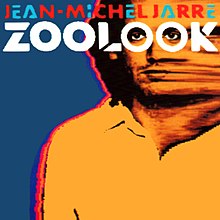|
Zoolook
Zoolook is the seventh studio album by French electronic musician and composer Jean-Michel Jarre, released in November 1984 by Disques Dreyfus. Much of the music is built up from samples of singing and speech in 25 different languages recorded and edited in the Fairlight CMI digital sampling synthesizer. The album spawned two singles: the title track and "Zoolookologie". Composition and recordingZoolook was greatly influenced by Jarre's former mentor Pierre Schaeffer and Schaeffer's musique concrète, taking samples from everyday life and human voices in 25 different languages from all over the world.[5][6] The sample-based approach, which had been initiated on Les Chants Magnétiques (1981) and continued on Music for Supermarkets (1983), was expanded on this album. Some fragments were recorded digitally by Jarre and then played back and edited on the Fairlight CMI.[7] This process was done together with Frederick Rousseau for three months.[8]
Some of the vocals were recorded during Jean-Michel's travels, while others are instead the result of his work with Xavier Bellanger, a French ethnologist who during his travels recorded "a large collection of tapes". For this album, Jarre used synthesizers like the Moog 55, ARP 2600, some by EMS, the LinnDrum machine, the Yamaha DX7,[10] the Matrisequencer 250 designed by French sound engineer Michel Geiss for Équinoxe (1978),[10][11] and the E-mu Emulator.[12] The different languages as listed in the album's liner notes are: Aboriginal, Afghan, Arabic, Balinese, Bengali, Chinese, Dutch, English, Eskimo, French, German, Hungarian, Indian, Japanese, Malagasy, Malayan, Pygmy, Polish, Quechua, Russian, Sioux, Spanish, Swedish, Tibetan, and Turkish.[13] Much of the album's recording took place in Jarre's makeshift studio in Croissy-sur-Seine, France (credited as Croissy Studio).[13] Sound engineer Denis Vanzetto joined Jarre's team, and later went to the Clinton studio, New York for recording American musicians chosen by Jean-Michel, among them guitarists Adrian Belew and Ira Siegel, bassist Marcus Miller, and percussionist and drummer Yogi Horton.[8][14] After Jean-Michel read in the American newspaper The Village Voice about an exhibition held by the avant-garde singer Laurie Anderson in a New York gallery, he called and invited her to the studio to listen to his demos. Seduced by Jarre's proposed idea of speaking a completely imaginary language, she agreed and provided the vowels for the track "Diva".[8][12] Parts of the album, like the track "Blah Blah Café" and the second half of the track "Diva", were reworkings of material that had already appeared on the 1983 album Musique pour Supermarché.[8] The album was mostly mixed by David Lord: final mixing began at Trident Studios in London, but Jarre wasn't satisfied with the results, so he and Lord finished mixing at Jarre's home studio in France.[13][15][12] ReleaseZoolook was released in November 1984,[16][17] with a second edition, containing remixes for Zoolook and Zoolookologie, in September 1985.[18][19] More aurally challenging than Jarre's previous works, the album was also somewhat less successful, reaching only number 47 in the UK album charts.[20] Two singles from the album were released – the title track and "Zoolookologie". Both had a music video in 1985. The title track video was directed by Jean-Pierre Jeunet[21] and featured twelve robots designed by Marc Caro, of which only one was kept after filming.[22] The video of "Zoolookologie" was directed by Rod McCall and produced by Frank Coppola in London, UK.[23] It "shows three models flirting with the artist in a provocative fantasy".[18] In 1984, the album won the Grand Prix du Disque award by L'Académie Charles Cros,[24] and in April 1985 it won the best instrumental album of the year award, at the Victoires de la Musique.[14] In 2016, a contest called Zoolook Revisited was organized, in which amateur or professional producers were invited to share a piece using samples taken from the SoundHunters app. Tracks from winners such as Luke Vibert, Zeka Lopez, Mikael Seifu, Simonne Jones and KIZ were chosen by Jean-Michel himself and were included on the disc of the same name.[25] Critical reception
At the time of its release NME said: "Strangely simplistic, this LP is like a union between Scary Monsters (and Super Creeps) and Kraftwerk on speed".[27] Australian newspaper The Evening News commented that "is a phonetic symphony laced with catchy, funk-rock rhythms based on the intonations of various exotic languages".[28] In Montréal (Québec), Le Devoir felt that the beginning of the album was "a musical background both morbid and grandiose".[29] In Mojo magazine, Phil Alexander listed it as one of Jarre's three key albums and wrote that "Jarre's rumination on internationalism also boasts a deliberate melodic focus that acknowledges the influence of synth pop, while pointing the way forward to greater experimentation – both in his own work and that of others".[17] AllMusic's John Bush stated that "Jean Michel Jarre combined an actual band and processed vocal samples – recorded in 25 different languages – with his rich, melodic synthesizer pop", described the album as "interesting throughout" and added that "the tracks with Jarre alone are often the best, reprising the classic Oxygène sound".[26] "Zoolookologie" was described by Thom Holmes as a "fascinating exploration of samples both of voice and drums".[30] Track listingFirst edition – original track list (1984)
Second edition (1985)
Third edition (1997 remaster)
Fourth edition (30th anniversary, 2015 remaster)
Fifth edition (40th anniversary - new mastering)The following is a track listing of the initial release on streaming platforms on November 8th, 2024, closely following the first edition from 1984 (both with regards to track lengths and the mixes of Zoolook and Zoolookologie). Due to multiple production errors (most notably audible in Ethnicolor) it was withdrawn and replaced in December 2024 with a remaster done from a different source.
Track listing as of December 2024. The source material used is the same as the third edition from 1997 (different edits of Ethnicolor and Diva, and a different mix of Zoolook)
PersonnelPersonnel listed in album liner notes.[13]
EquipmentAdapted from album liner notes.[13]
Charts
Certifications
References
Bibliography
External links |
|||||||||||||||||||||||||||||||||||||||||||||||||||||||||||||||||||||||||||||||||||||||||||||||||||||||||||||||||||||||||||||||||||||||||||||||||||||||||||||||||||||||||||||||||||||||||||||||||||||||||||||||||||||||||||||||||||||||||||||
Portal di Ensiklopedia Dunia
